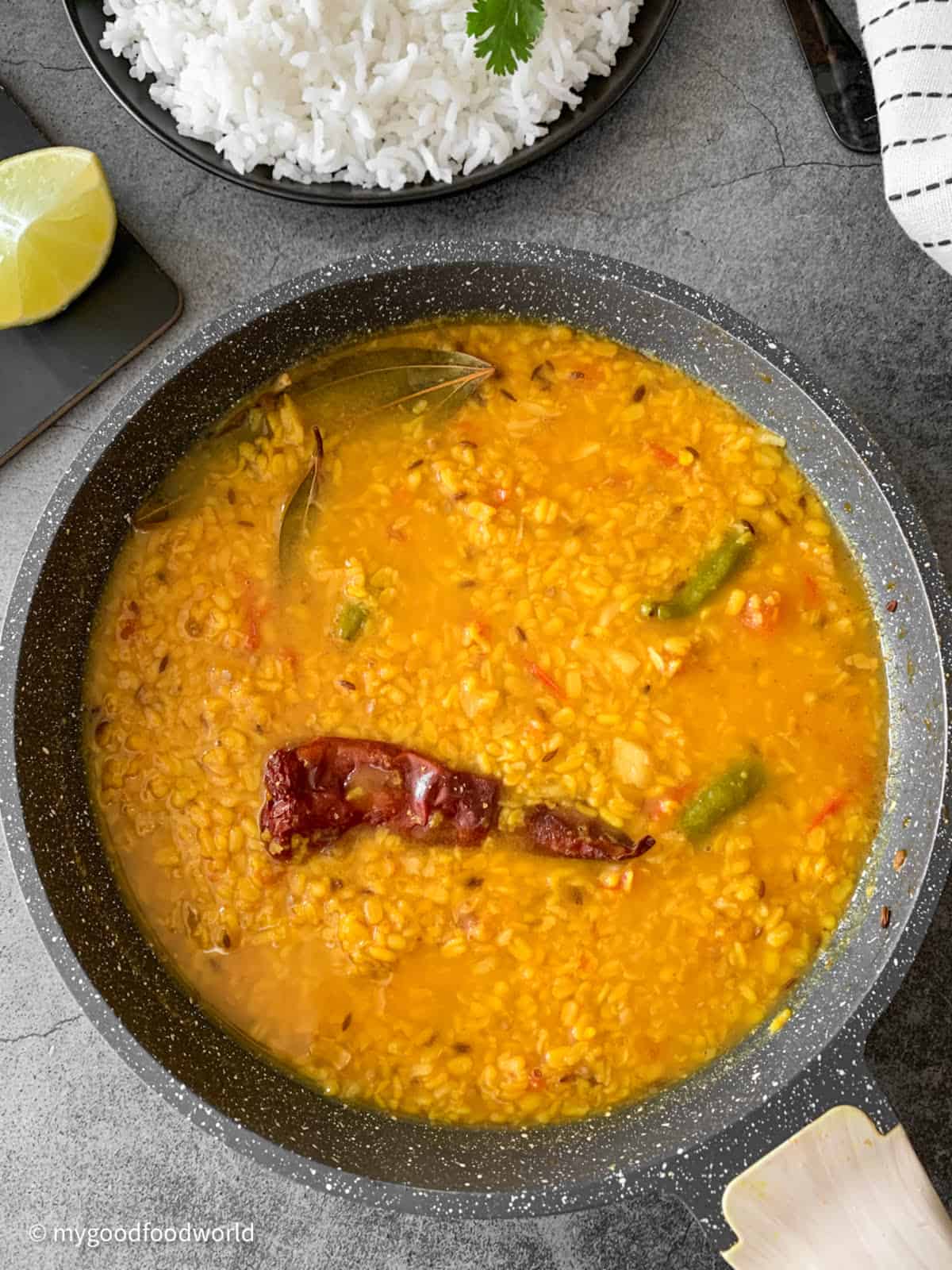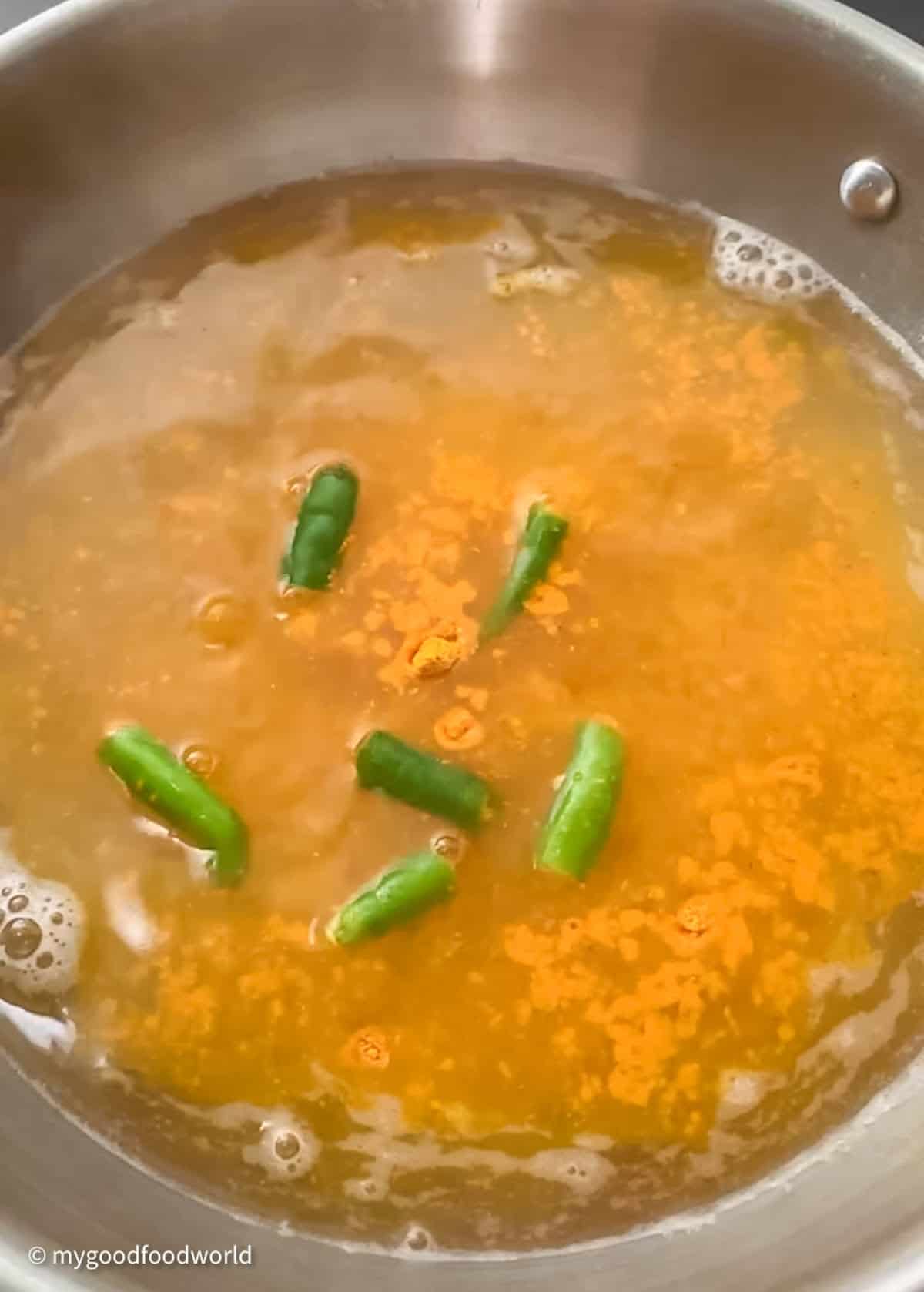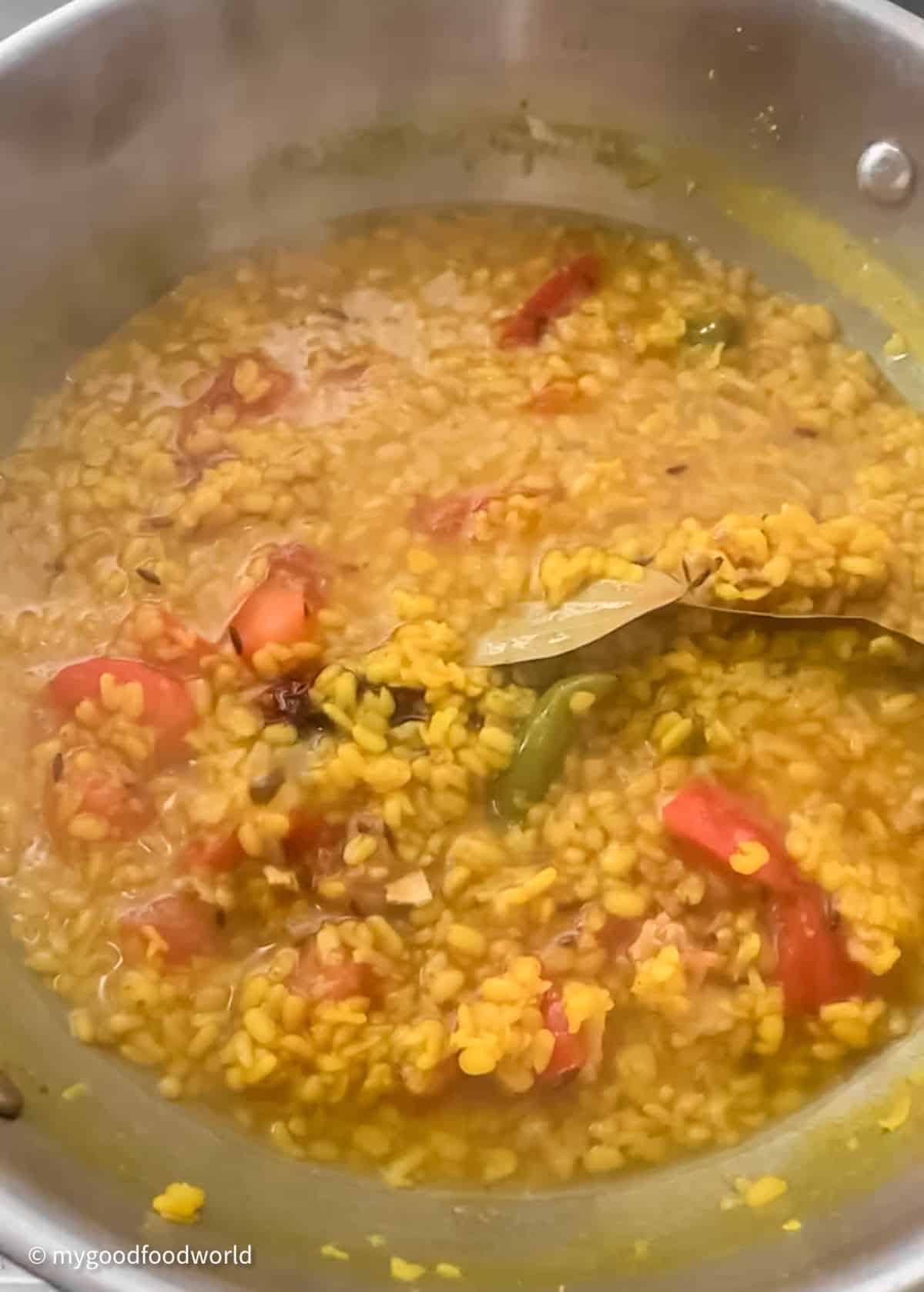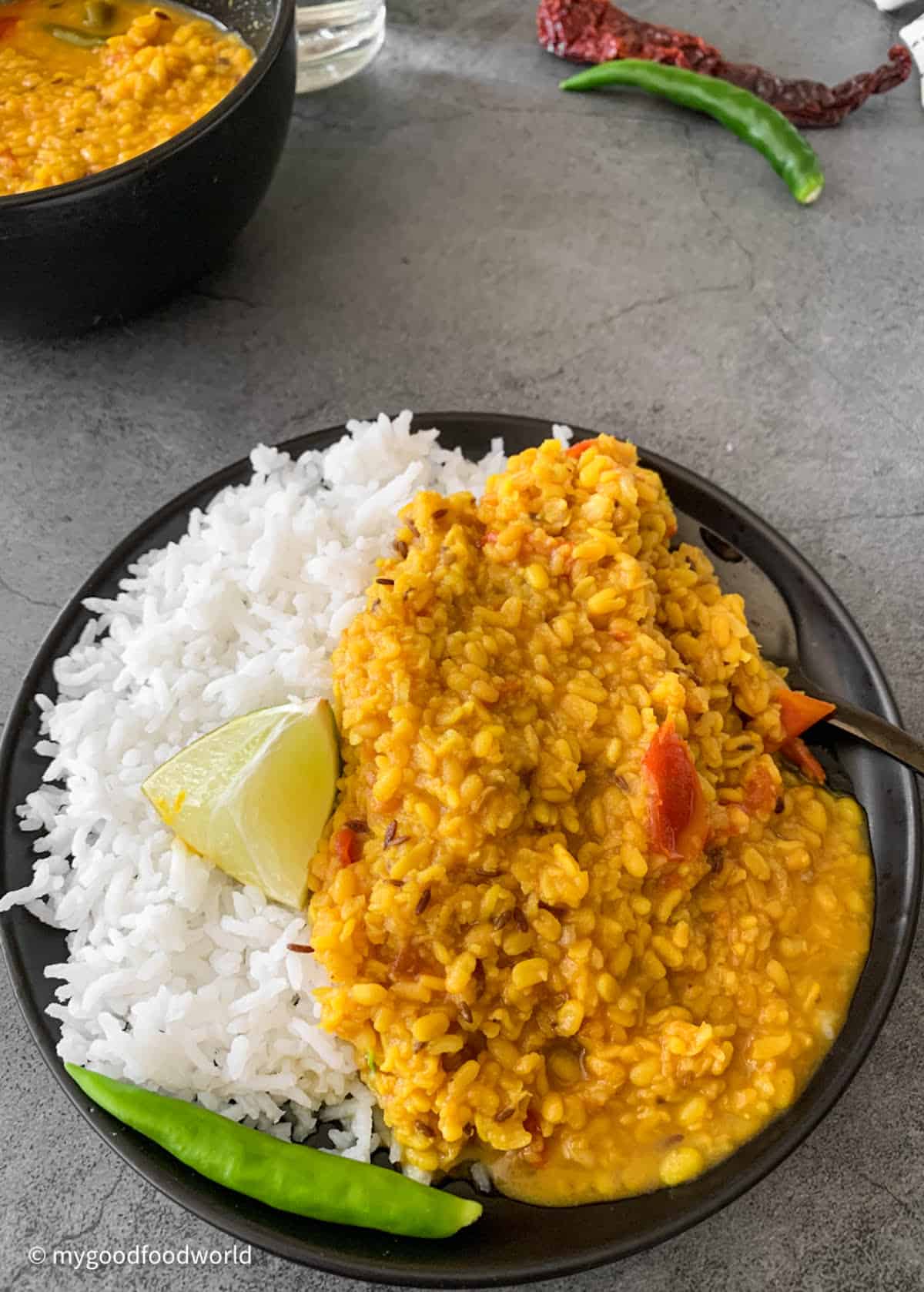This post contains helpful notes and tips to help you make the perfect dish. However, if you are in a rush, please use the “Jump to Recipe” link above or the “Jump to” links below to get to the section you want. On certain days, I feel like eating sattvic food i.e., food that is simple, easy to digest, and gives me a good feeling of being full. I reserve this Bengali moong dal recipe, this zucchini kootu and sauteed bottle gourd for those days. These are dishes that mean comfort to me. I learned to make this flavorful dal dish from a friend’s mom in Kolkata. She told me that this bhaja moong-er daal is one of the gems of Bengali cuisine. Bhaja means roasted. I have fond memories of eating this dish as part of a wholesome meal with some plain rice, bitter gourd and aloo bhaja, sour Bengali chutney, and extra crispy fritters. They would have some fish head stew as well.
Ingredients
If you have any questions regarding these ingredients, feel free to ask in the comments section below and I will try my best to answer them for you.
gluten grains nuts soy
Make it tomato free: Just skip the tomato and add a dash of lime juice instead. Make it vegan: Use any neutral oil instead of ghee.
Moong dal: These are split yellow lentils, also known as moog dal in Bengali.
Whole spices: Cumin seeds, dried red chilli, and bay leaf. Bay leaves add a distinctive and unique flavor to this dish.
Ghee: This is traditionally made with ghee. You can substitute it with any good quality neutral oil.
Ginger: I use fresh ginger and crush it using a mortar and pestle. You can grate or mince is, if that works better for you. Ginger paste will work as well.
Green chillies: These are more for their flavor than their heat.
To finish off: These garnishes are totally optional. Add all or any of these: ghee, grated ginger, chopped coriander leaves (cilantro), bhuna jeera.
Instructions
Any doubts or questions? Feel free to ask via the comments below. I will try my best to answer them for you. - Padma Also see the video at the end of the recipe card below. Step 1: Prepare the lentils and other ingredients. Add the lentils to the pan on medium flame. Roast them till they are golden brown. Stir and keep an eye on them to ensure that they are evenly colored. Tip the roasted dal to a bowl. Wash, drain and keep aside. Chop the chili peppers into 2-3 pieces, each. Dice the tomatoes. Crush, or mince the ginger. Measure the rest of the ingredients. Step 2: Make the moong dal. Put the pan back on medium-high heat and add the dry roasted moong daal and 3 and ½ cups of water. Add the turmeric and chopped green chilies. Stir and boil dal until soft but the lentils still hold their shape. Partially cover the pan with a lid to speed up the cooking. The water will boil over if you fully cover the pan with the lid. Hint: You can tell that the lentils are cooked when they split on their sides. They need just a few more minutes to become soft and creamy. Step 3: Temper the spices. While the lentils are cooking, place a skillet on medium heat. Add the ghee and whole spices. Fry till the cumin become darker in color and the bay leaves are aromatic. Add the crushed ginger, chopped tomatoes and salt. Cook for a few minutes until the tomatoes soften, but don’t turn mushy. Add these spices to the lentils as they cook. Mix well. Cook, on low heat, for 2-3 minutes more, letting the flavors blend and the lentils finish cooking. Check for salt and add more if required. If the dal is too thick, add ½ cup more water. Finish off with garnishes, if using. Serve as a main with rice or roti. See the section below for more suggestions. Making it in a pressure cooker or an Instant Pot: Follow the same steps as above and cook for 6-7 minutes (2 “whistles”) on high pressure. Release the pressure manually. Remove the lid and add the tempered spices. Then put the lid back on for a few minutes to let the flavors blend. The lentils cooked this way will be softer and more mushy than the stovetop method. Onion and garlic: This recipe is traditionally made without onion and garlic. If you prefer, you can add some finely chopped onion and garlic when you temper the spices. Fry them for a couple of minutes after adding the whole spices. Then add the ginger and tomatoes. Consistency: This sumptuous Bengali style moong dal has a thick consistency that is perfect for pouring over rice or scooped up with some bread. If you want to have it on its own, as a soup, you can thin it by adding 1 cup of water. See this summery version yellow lentil soup on my website! Substitutions:
Swap the ghee with neutral oil to make this a vegan recipe. Skip the tomatoes and add a dash of lime juice instead.
Variations:
More flavor - add 1 teaspoon of panch phoron (five spice mix), 1 tbsp. mustard oil, and ½ teaspoon garam masala powder. Spicier: If you like a spicy kick, add ½ teaspoon red chili powder at the time when you add the turmeric to the lentils. No moong lentils? You can use red lentils (masoor dal). Add vegetables: To make it more filling and nutritious, you can add some vegetables. Cauliflower florets, green peas, and diced potatoes are typically added to it. Bengalis call this version “shobji diye bhaja muger dal”.
Roasting the lentils: This is a crucial step to get the flavour for this Bengali dal recipe. Roast them on medium heat and stir them constantly to get an even colour. The lentils should be golden brown. Texture: The lentils should not be mushy, unlike in this dal palak. Roasting the lentils prevents this to a large extent. Ghee: This is important for the unique flavor of this dish. Try not to skip this ingredient if you can. If you have enjoyed reading this, please take a moment to leave a comment and a rating below. This will motivate me to create more good content for you! You can also engage with me on Twitter, Facebook, and Instagram. - Padma If you, like me, love having this the way a Bengali household will serve it, then have it with some plain hot rice, green beans and aloo posto (poppy seeds), baingan bhaja (pan-roasted aubergine), a wedge of lime and a green chilli. You can also enjoy this dal with some flat bread. I love having it with buckwheat naan - a great option for a grain-free meal. Storage: This dal can keep in the fridge for 3-4 days. Cool it completely and store it in an airtight, fridge-safe container.
📖 Recipe
Disclosure: The nutritional information is calculated using an online calculator and is based on available ingredients and preparation. It should not be considered a substitute for a professional nutritionists’ advice. Changing the quantities and cooking technique will alter the nutritional calculations.











